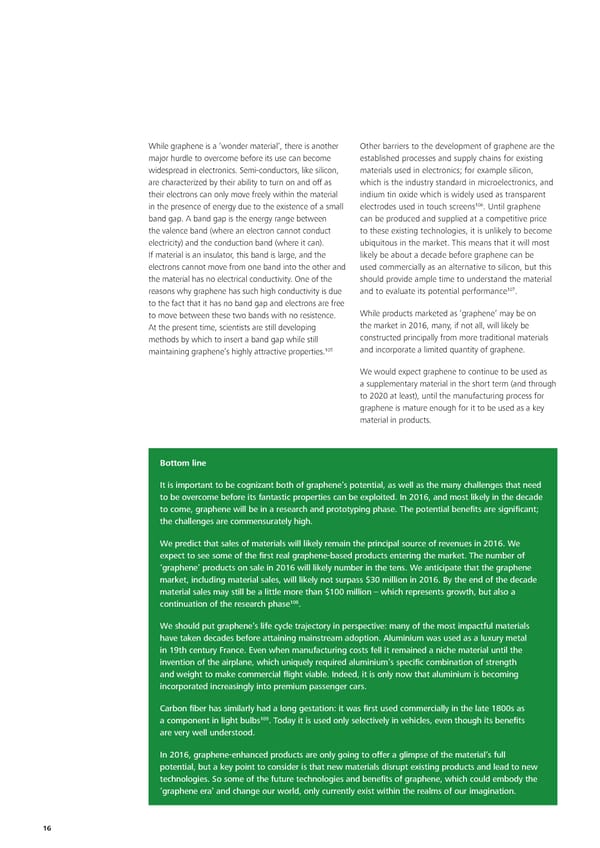While graphene is a ‘wonder material’, there is another Other barriers to the development of graphene are the major hurdle to overcome before its use can become established processes and supply chains for existing widespread in electronics. Semi-conductors, like silicon, materials used in electronics; for example silicon, are characterized by their ability to turn on and off as which is the industry standard in microelectronics, and their electrons can only move freely within the material indium tin oxide which is widely used as transparent 106 in the presence of energy due to the existence of a small electrodes used in touch screens . Until graphene band gap. A band gap is the energy range between can be produced and supplied at a competitive price the valence band (where an electron cannot conduct to these existing technologies, it is unlikely to become electricity) and the conduction band (where it can). ubiquitous in the market. This means that it will most If material is an insulator, this band is large, and the likely be about a decade before graphene can be electrons cannot move from one band into the other and used commercially as an alternative to silicon, but this the material has no electrical conductivity. One of the should provide ample time to understand the material 107 reasons why graphene has such high conductivity is due and to evaluate its potential performance . to the fact that it has no band gap and electrons are free to move between these two bands with no resistence. While products marketed as ‘graphene’ may be on At the present time, scientists are still developing the market in 2016, many, if not all, will likely be methods by which to insert a band gap while still constructed principally from more traditional materials 105 and incorporate a limited quantity of graphene. maintaining graphene’s highly attractive properties. We would expect graphene to continue to be used as a supplementary material in the short term (and through to 2020 at least), until the manufacturing process for graphene is mature enough for it to be used as a key material in products. Bottom line It is important to be cognizant both of graphene’s potential, as well as the many challenges that need to be overcome before its fantastic properties can be exploited. In 2016, and most likely in the decade to come, graphene will be in a research and prototyping phase. The potential benefits are significant; the challenges are commensurately high. We predict that sales of materials will likely remain the principal source of revenues in 2016. We expect to see some of the first real graphene-based products entering the market. The number of ‘graphene’ products on sale in 2016 will likely number in the tens. We anticipate that the graphene market, including material sales, will likely not surpass $30 million in 2016. By the end of the decade material sales may still be a little more than $100 million – which represents growth, but also a 108 continuation of the research phase . We should put graphene’s life cycle trajectory in perspective: many of the most impactful materials have taken decades before attaining mainstream adoption. Aluminium was used as a luxury metal in 19th century France. Even when manufacturing costs fell it remained a niche material until the invention of the airplane, which uniquely required aluminium’s specific combination of strength and weight to make commercial flight viable. Indeed, it is only now that aluminium is becoming incorporated increasingly into premium passenger cars. Carbon fiber has similarly had a long gestation: it was first used commercially in the late 1800s as 109 a component in light bulbs . Today it is used only selectively in vehicles, even though its benefits are very well understood. In 2016, graphene-enhanced products are only going to offer a glimpse of the material’s full potential, but a key point to consider is that new materials disrupt existing products and lead to new technologies. So some of the future technologies and benefits of graphene, which could embody the ‘graphene era’ and change our world, only currently exist within the realms of our imagination. 16
 Technology, Media & Telecommunications Predictions Page 20 Page 22
Technology, Media & Telecommunications Predictions Page 20 Page 22